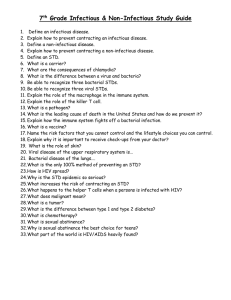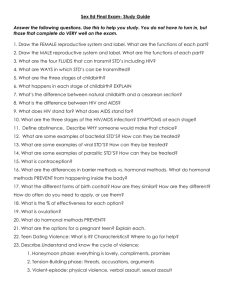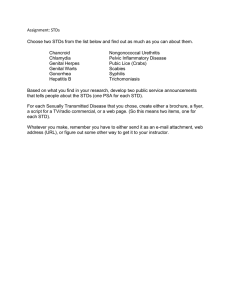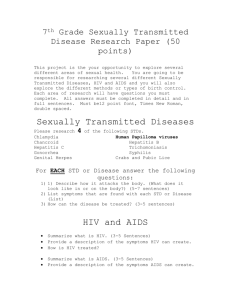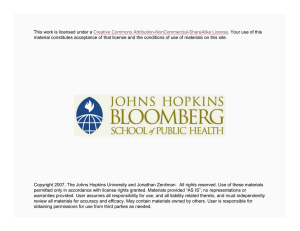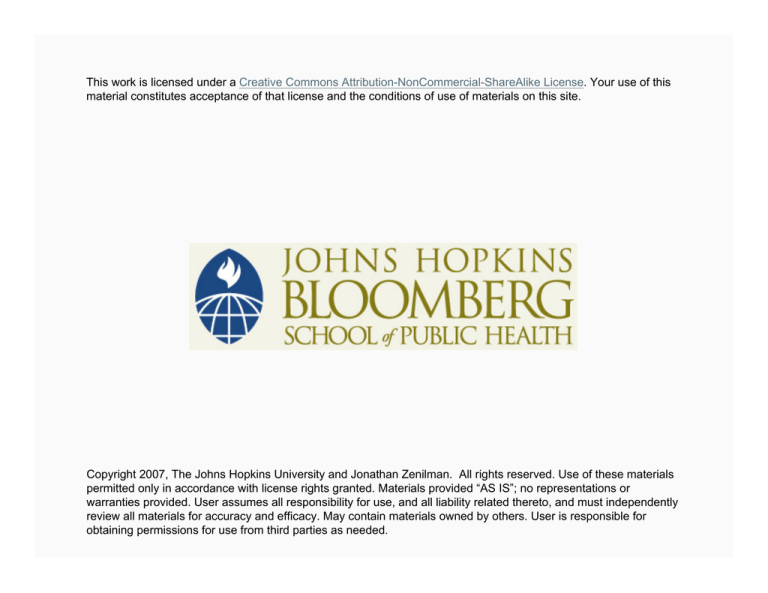
This work is licensed under a Creative Commons Attribution-NonCommercial-ShareAlike License. Your use of this
material constitutes acceptance of that license and the conditions of use of materials on this site.
Copyright 2007, The Johns Hopkins University and Jonathan Zenilman. All rights reserved. Use of these materials
permitted only in accordance with license rights granted. Materials provided “AS IS”; no representations or
warranties provided. User assumes all responsibility for use, and all liability related thereto, and must independently
review all materials for accuracy and efficacy. May contain materials owned by others. User is responsible for
obtaining permissions for use from third parties as needed.
Epidemiologic Basis of STD Control II —
Interventions
Jonathan Zenilman
Johns Hopkins University
Section A
Groups and Mixing Patterns
Core Neighborhoods and Core Transmitters
Core neighborhoods—geographic units with high
prevalence of STDs
Core transmitters—individuals in core neighborhoods
who engage in “risky” social behaviors and experience
a large proportion of diagnosed STDs
4
Core Groups and Transmission Dynamics
Core groups are critical to maintaining high rates of
gonorrhea in community-based models of STD
transmission
− Cores are characterized by high transmission
density
5
Neighborhood Characteristics and STD Link
Studies have consistently found higher rates of STDs in
neighborhoods with the following characteristics:
− Poverty
− Social disadvantage
− Segregation (Thomas, 1995)
− Drug abuse
Few studies have linked community level
characteristics to individuals
6
The Unique Aspect of STD-Partner Effects
Without partners, there is no STD
STD prevalences are different in different populations
Therefore, “types” of partners may have an enormous
impact on STD risk
7
Sexual Mixing
The extent of sexual contact within
and among definable segments of
the population
Segments of the population can be defined by factors
such as
− Age, race/ethnicity, sex
− Geography
− Drug-use patterns
8
Partner Mixing Patterns
“Assortative” mixing (or “like with like”)
− In other words, partners are recruited from a
population whose STD risk is demographically
similar to one’s own
− For example, the next-door neighbor is a good
approximation of assortative mixing!
“Dissortative” mixing—recruitment of partners from
different groups
− For example, contact with commercial sex workers,
or with persons from different ethnic groups
− “Mixed”—many people have assortative and
dissortative mixing patterns
9
Mixing Pattern
Assortative
Source: Boily STD, 2000:27(10);560-71
Random
Disassortative
10
Sex Partner Selection and Mixing Patterns
Laumann, 1998
− Higher STDs in African Americans is
partly due to patterns of sexual networks
− STDs remain endemic because partner selections
are more assortative by race/ethnicity
− Partner selection is more disassortative by
demographic characteristics among AfricanAmericans than other groups
11
Sex Partner Selection and Mixing Patterns
Aral, 1996
− STD morbidity concentrations create potential
partner pools of high risk and high sexually
transmitted disease
− These geographic and social contexts create a
higher probability of exposure to infection for each
sex act
12
Public Health Strategies: Core Transmitters
CORE GROUP
People who have sex with both groups
General Population
13
Serial vs. Parallel Transmission
Infected
Uninfected
Infected
Best Friend
Uninfected
Infected
14
Chain Design: Urban Network Study
Chain-link study design for Atlanta Urban Networks
Project, 1995-1999.
Recruited six `chains' of persons,
− random selection of the next interviewee
or
− nomination by the previous interviewee
These six chains provided information on personal
behavior and network association.
15
Phases of STD Epidemics
Hyper endemic
Growth
Decline
Endemic
Baseline
Source: Adapted from Wasserheit and Aral. JID 1996.
16
Network Approach
Find, evaluate, and treat both sex and social partners
− Inquire about index’s social network
− Rely on other sources of information besides
interviews (e.g., community residents)
− Include places of social significance
17
Summary
Networks are the construct which integrate “core”
transmitters into STD epidemiology
Dense networks are required to maintain STD
endemicity, since the random infection transmission
efficiency is <100%
“Core” network members- individuals with high
“centrality” are key to population-based control-but
this has never been widely actualized
18
Questions
What are the challenges to implementing a network
disease intervention approach?
− Stigma
− Outcome evaluation
− Process indicators?
19
Section B
Theoretical Aspects of STD Control
R=Bcd Partner Exposures—Interventions
Behavioral risk reduction (“c” term)
− Abstention
− Reducing number of partners
− Reducing number of exposures
− Increasing age of sexual debut
Partner selection—multifactorial term
− e.g., high-risk vs. low-risk partners!
21
Partner Notification—Efficacy
Impacts “d”
Studies in HIV and STD settings demonstrate that
provider referral usually increases yield
PN is an expensive intervention and requires intensive
supervision and personnel resources
Cost-effectiveness data is inconclusive
22
Partner Notification—Methods
Patient referral (usually with referral card)
Provider referral (interview patient for sex partners
with field follow-up)
Conditional referral
23
Field Record
24
R=Bcd Duration of Infection—Interventions
Reduction of d = reduction of asymptomatic pool
Disease screening programs
Partner notification and presumptive treatment
Increased health care access
Treatment guidelines
25
STD Screening Programs
Syphilis $
Gonorrhea $$
Chlamydia $$$
HIV$$
26
Setting up STD Screening
Identifying appropriate populations
Laboratory quality assurance
Transport, logistical, and supply issues
Costs and cost allocation
Development of new technology
Notification of results
27
The Screening Process
Clinic
Specimens
Results
Lab
28
Major Issues in Screening Programs
Poor logistics
Follow-up issues
Inappropriate populations
Insurance/legislative problems
29
Partner Notification
No controlled studies performed
Probably useful for diseases with long incubation
period (syphilis, chlamydia)
Used for HIV
Not useful in most settings for diseases with short
incubation periods
Sexual network vs. social network issues
d
30
Parran’s Model
Interview the infected person
Identify their sex partners
Find, evaluate, and treat sex partners
31
Prevention Therapy
Presumptive treatment of sexual contacts
Syndromic management
Intentional over-treatment in most settings
Impact on resistance-minimal—especially when single
dose regimens are used
Major Issue: identification of contacts
32
Partner Therapy and Viral STDs
Not generally indicated
PEP for HIV- used in practice, efficacy unknown
33
Prevention and Partner Therapy
Challenge to Partner management is access
− New Approaches
X Pharmacy delivered
X Partner Delivered
X
X
What do you think would be the challenges to
these methods of partner management?
(See New Engl J med Feb 17 2005)
34
Section C
Transmission Efficiency
Transmission Efficiency of STDs
STD B not 100%
30-70% per GC/CT exposure
~20-30% syphilis
HIV: 1/100- 1/10,000 depending on type of exposure
36
Impact of B Reduction
Reducing transmission efficiency should have a direct
effect on individual risk
Example: Consistent condom use reduces HIV
transmission by >98% in dichotomous couples
Population Impact on STD transmission-modeling
studies suggest that modest reductions in B have
greater impact
37
R=Bcd Transmission Efficiency—Interventions
Condom use and barrier methods
Microbicides
Hormonal contraceptives (?)
Circumcision (?)
Antiviral therapy (?)
− “Doc, now that my viral load is zero, do I still have
to use a condom … Can I get a prescription for
Viagra? …”
38
Microbicides
Female controlled methods
Nonoxynol-9 studies demonstrate ineffectiveness for
CT, GC
For HIV, most data now suggests that mucosal
disruption by N-9 may facilitate HIV transmission
New compounds being developed, especially nonionic, antibody approaches
39
Microbicides: Mechanisms of Action
Modes of action of new vaginal microbicides. (CAP, cellulose acetate phthalate;
NNRTI, non-nucleoside reverse transcriptase inhibitor). Reproduced with permission
from McCormack S, et al. Science, medicine, and the future: Microbicides in HIV
prevention. BMJ 2001;322:410-413. Copyright © 2001 BMJ. All Rights Reserved.
40
Microbicides: Desirable Characteristics
Efficacy
Texture
Chemical interactions—pH
Taste and smell
“Stealth”
Non-toxic to sperm
41
Vaccines
Hepatitis B vaccine is the only STD vaccine
SKGlaxo herpes vaccine—effective for women, not
men
− Continued clinical trials
HPV vaccine-preventive and therapeutic, in Phase 1,2
and Phase 3
GC and chlamydia-little activity
HIV vaccines
42
Condom Use
Condom efficacy demonstrated for HIV, GC, herpes.
Biologically plausible
Population Impact-Thailand, Uganda
43
Condom Use Patterns
Condom use often measured as consistent use
Use patterns often include use with higher-risk
partners-potential for paradoxical effects
Appropriate use requires training (technical efficacy)
and negotiation skills
44
Antiviral Therapy
Suppressive treatment of persons with herpes reduces
transmission for individuals in dichotomous
relationships
Supposition that HIV treatment would do the same
Impact of STD and HIV interaction
45
Sexual Transmission of HIV
HIV pattern is that viral load is highest during
seroconversion
Early seroconverters are HIV-negative
Is sexual transmission during HIV seroconversion the
greatest public health risk??
46

